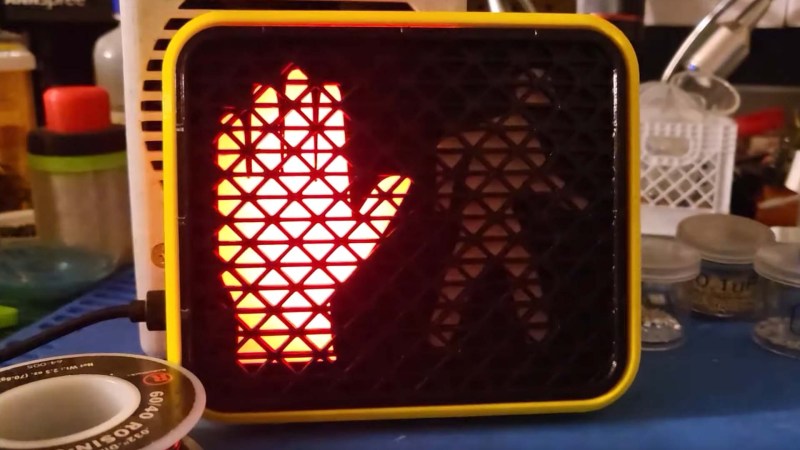There’s just something so pleasing about scaled-down electronic replicas, and this adorable 3D printed pedestrian crossing light by [sjm4306] is no exception.
Although a little smaller than its real-world counterpart, the bright yellow housing and illuminated indicators on this pedestrian lamp are instantly recognizable due to their ubiquitous use throughout the United States. The handful of printed parts are held together using friction alone, which makes assembly a literal snap. The ‘safety grill’ with its many angles ended up being one of the most tedious parts of the build process, but the effort was definitely justified, as it just wouldn’t look right without it.
A suitably minuscule ATtiny85 drives a pair of LED strips that effectively mimic the familiar symbols for ‘Walk’ and ‘Don’t Walk’. [sjm4306] has designed the board and case in such a way to accommodate a variety of options. For example, there’s just enough room to squeeze in a thin battery, should you want to power this contraption on-the-go. If you don’t have an ATtiny85 on hand, the board also supports an ATmega328p or even an ESP8266.
All the build details are available over on Hackaday.io. While it’s billed as a ‘night light’, we think this could be an awesome platform for an office toy, similar to this office status light project. Or if you’ve somehow already got your hands on a full-size pedestrian lamp, why not hook it up to the Internet?
















I really like the look of it, but I don’t think that’s how crossing lights work. This does red blink for 10 sec, red solid for 10 sec, red blink for 10 sec, then white solid for 10 sec, and loop. At least all the lights I’ve seen are red solid for x sec, red blink for x sec, white solid for x sec, white blink for x sec, and loop. The blink should indicate the coming change to the opposite color. It’s a simple fix.
Correction: white blinks to show the coming change to red, but red doesn’t ever blink… I think. XD we really need an edit button.
I think I’m going to have to go outside and stare at a crosswalk for a bit.
I’m pretty sure he’s got this right. It’s a great build, and yet half the video is about all the small details that went wrong. I like that. It’s the difference between mercedes and skoda.
That’s not how they work anywhere I’ve seen in the US. The patterns I’m used to cycle through three modes in the following order:
Solid white pedestrian: Begin crossing
Flashing red hand: Continue only if already crossing
Solid red hand: Do not cross
I don’t think I’ve ever seen white blink. I usually see white solid, then red blink, then red solid, then repeat.
At least, that’s how they work in NYC!
Neat build; for the safety grill, it might be easier to make a ‘solid’ slab, and since it’s 3d-printed, configure the slicer to have no top or bottom layers and use an appropriate infill percentage and pattern for the grill- let the slicer do the hard word for that. :)
“…the bright yellow housing and illuminated indicators on this pedestrian lamp are instantly recognizable…”
No, not really. Perhaps you should start to consider HaD as a global website, not just some local US news site.
Well, the article did specify the united states. I would like to see an Ampelmann (spl?) version though!